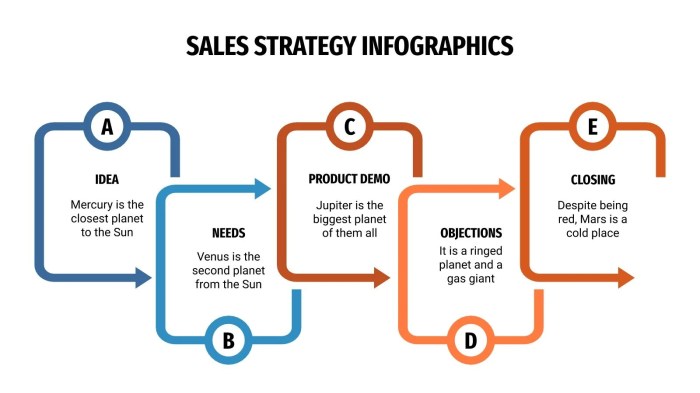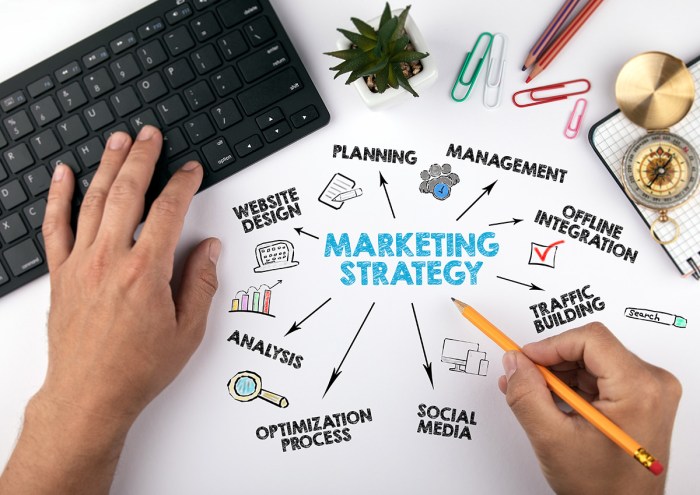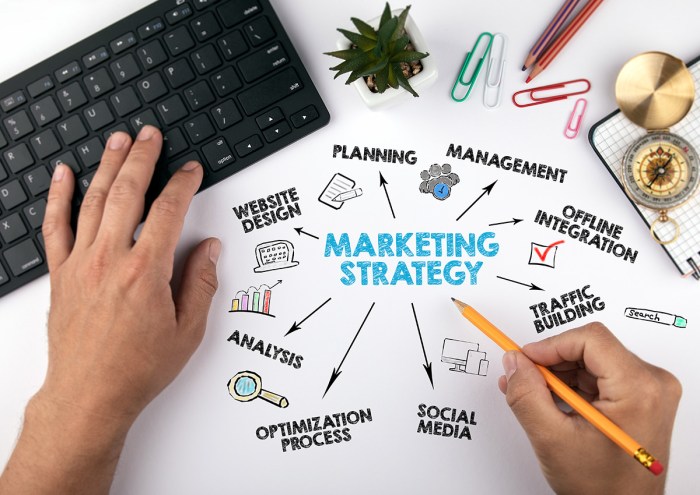Kicking off with Developing Sales Strategies, this opening paragraph is designed to captivate and engage the readers, setting the tone american high school hip style that unfolds with each word.
When it comes to boosting sales and driving business growth, having effective strategies in place is key. From understanding the market to identifying the target audience and optimizing the sales funnel, a well-thought-out plan can make all the difference. Let’s dive into the world of developing sales strategies and explore how top companies succeed in this game of salesmanship.
Understanding Sales Strategies

Developing effective sales strategies is crucial for the success of any business. It helps companies identify their target market, differentiate themselves from competitors, and ultimately drive revenue growth.
Examples of Successful Sales Strategies
- Apple’s Product Launch Strategy: By creating hype and anticipation around new product launches, Apple generates massive sales and brand loyalty.
- Amazon’s Personalization Strategy: Amazon uses data-driven insights to personalize product recommendations, leading to higher conversion rates and customer satisfaction.
- Zara’s Fast Fashion Strategy: Zara’s quick turnaround time from design to store shelves allows them to capitalize on current trends and attract repeat customers.
Impact of Sales Strategies on Business Growth
Sales strategies directly impact a company’s bottom line and overall growth. A well-executed sales strategy can lead to increased market share, customer retention, and profitability. On the other hand, a poorly developed sales strategy can hinder growth and limit a company’s success in the competitive business landscape.
Market Research and Analysis

Market research is a crucial step in developing effective sales strategies. It involves gathering and analyzing data about the market, competitors, and target customers to make informed decisions. By understanding the market landscape, businesses can tailor their sales approaches to meet the needs and preferences of their customers.
Conducting Market Research
- Identify target market segments and demographics to focus sales efforts.
- Analyze industry trends and forecasts to anticipate changes in consumer behavior.
- Collect data on competitors’ pricing, products, and marketing strategies to identify gaps and opportunities.
Key Metrics for Market Analysis
- Market Size: Determine the total addressable market to assess the potential for sales growth.
- Market Share: Evaluate your company’s market share compared to competitors to identify areas for improvement.
- Customer Satisfaction: Measure customer feedback and satisfaction levels to identify areas of improvement in sales processes.
Influence on Sales Strategy Development
Market analysis directly impacts the development of sales strategies by providing insights into customer needs, competitive positioning, and market trends. By leveraging data from market research, businesses can craft targeted sales approaches, set realistic sales targets, and optimize resource allocation to maximize revenue and profitability.
Target Audience Identification
Identifying the target audience is a crucial aspect of developing effective sales strategies. By understanding who your potential customers are, you can tailor your approach to meet their specific needs and preferences, leading to increased sales and customer satisfaction.
Methods for Defining and Segmenting Target Audiences Effectively
When it comes to defining and segmenting target audiences, there are several methods that can be utilized to ensure precision and accuracy:
- Demographic Segmentation: This involves dividing the audience based on factors like age, gender, income, education level, and occupation.
- Psychographic Segmentation: This focuses on the audience’s lifestyle, values, interests, and personality traits.
- Behavioral Segmentation: This looks at the audience’s purchasing behavior, such as frequency of purchases, brand loyalty, and usage rate.
- Technological Segmentation: This considers the audience’s preferred channels of communication and interaction, such as social media platforms or email.
Segmentation allows for a more personalized approach in sales strategies, making the message more relevant and appealing to each specific group.
Tailored Sales Strategies for Different Target Audience Segments
Once the target audience segments have been identified, it is crucial to develop tailored sales strategies to effectively engage each group:
- Customized Messaging: Craft messages that resonate with the values, interests, and needs of each audience segment.
- Channel Optimization: Utilize the preferred communication channels of each segment to deliver your message effectively.
- Pricing Strategies: Adjust pricing strategies based on the willingness to pay and budget constraints of each target audience segment.
- Promotional Offers: Create promotions and offers that cater to the specific preferences and behaviors of different audience segments.
Competitive Analysis: Developing Sales Strategies
When developing sales strategies, conducting a competitive analysis is crucial to understand the market landscape and position your products or services effectively. By analyzing your competitors, you can identify strengths, weaknesses, opportunities, and threats that can impact your sales approach.
Tools and Techniques for Competitive Analysis, Developing Sales Strategies
- SWOT Analysis: Examines strengths, weaknesses, opportunities, and threats of your competitors.
- Competitor Profiling: Gathering information on competitor products, pricing, marketing strategies, and target audience.
- Market Research: Collecting data on market trends, customer preferences, and competitive positioning.
- Mystery Shopping: Evaluating competitor’s customer experience and sales processes firsthand.
Benefits of Competitive Analysis
- Identifying Market Gaps: Understanding where your products/services can fill a need that competitors are not addressing.
- Strategic Positioning: Leveraging competitor weaknesses to differentiate your offerings and stand out in the market.
- Pricing Strategy: Adjusting pricing based on competitor pricing to remain competitive and maximize profitability.
- Marketing Insights: Learning from competitor marketing tactics to enhance your own marketing campaigns.
Sales Funnel Optimization
To optimize the sales funnel, it is crucial to understand the concept of a sales funnel and its role in sales strategy development. The sales funnel represents the journey that potential customers go through from being aware of a product or service to making a purchase. It consists of different stages, such as awareness, interest, decision, and action, each requiring specific strategies to move prospects smoothly through the funnel.
Optimizing Awareness Stage
The awareness stage is where potential customers first learn about your product or service. To optimize this stage, focus on creating compelling content, utilizing social media and strategies to increase visibility, and engaging with your target audience through educational materials or webinars.
Optimizing Interest Stage
During the interest stage, prospects are evaluating your offering. To optimize this stage, provide in-depth product information, offer personalized solutions, and showcase customer testimonials to build trust. Implement lead nurturing campaigns to keep prospects engaged and move them closer to making a purchase.
Optimizing Decision Stage
In the decision stage, prospects are ready to make a purchase but may need an extra push. Offer limited-time promotions, discounts, or free trials to encourage decision-making. Provide easy access to customer support and ensure a smooth checkout process to reduce friction and increase conversions.
Optimizing Action Stage
The action stage is where prospects become customers. To optimize this final stage, focus on delivering exceptional customer service, providing post-purchase support, and encouraging repeat purchases through loyalty programs or exclusive offers. Monitor customer feedback and address any issues promptly to maintain customer satisfaction.
Tracking and Analyzing Metrics
Tracking and analyzing metrics within the sales funnel is essential for evaluating the effectiveness of your strategies. Monitor key performance indicators (KPIs) such as conversion rates, customer acquisition costs, and average order value to identify areas for improvement. Use analytics tools to track customer behavior, measure campaign performance, and make data-driven decisions to optimize the sales funnel continuously.
Multi-channel Sales Approach
In today’s competitive market, adopting a multi-channel sales approach can provide numerous benefits for businesses looking to increase their sales and reach a wider audience. By utilizing various sales channels, companies can diversify their outreach efforts and engage with customers through different touchpoints, ultimately leading to higher conversion rates and customer satisfaction.
Benefits of Multi-channel Sales Approach
- Increased Reach: By leveraging multiple sales channels such as online marketplaces, social media platforms, and physical stores, businesses can expand their reach to different customer segments.
- Diversification: Having multiple channels allows companies to mitigate risks associated with relying on a single sales platform, ensuring consistent revenue streams.
- Enhanced Customer Experience: Offering customers the flexibility to purchase through their preferred channel improves overall satisfaction and loyalty.
Examples of Sales Channels
- E-commerce Websites: Creating a user-friendly online store where customers can browse and purchase products.
- Social Media Platforms: Utilizing platforms like Instagram and Facebook to showcase products, run promotions, and interact with customers.
- Retail Stores: Establishing physical locations where customers can see and touch products before making a purchase.
Enhancing Customer Engagement and Conversion Rates
Integrating various sales channels allows businesses to meet customers at different stages of the buying journey, providing a seamless shopping experience. For example, a customer might discover a product on social media, research it on the company’s website, and then make a purchase in-store. This omni-channel approach not only increases customer engagement but also boosts conversion rates as customers move smoothly through the sales funnel.
